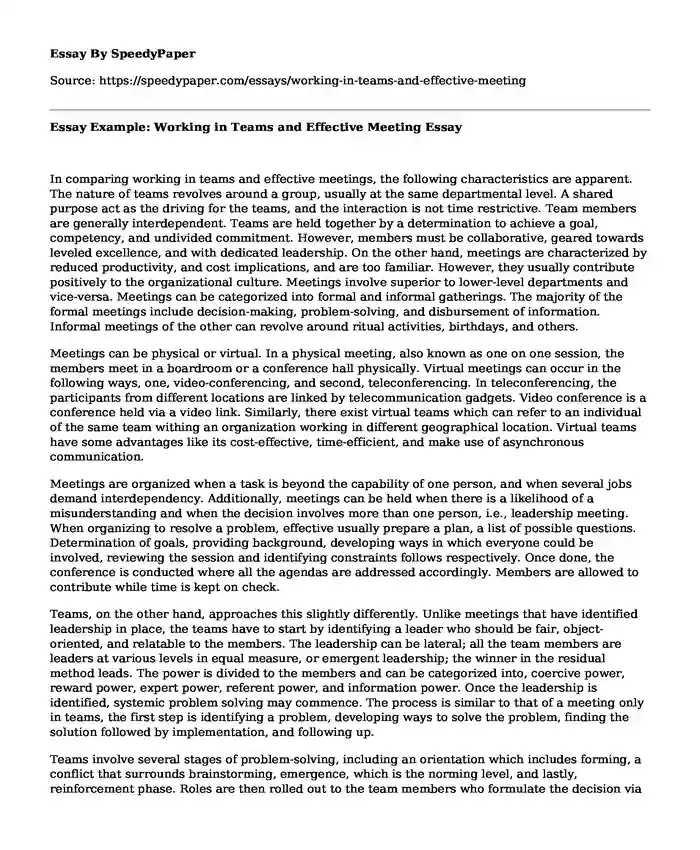
| Type of paper: | Essay |
| Categories: | Goal Communication Human resources Organizational culture |
| Pages: | 3 |
| Wordcount: | 718 words |
In comparing working in teams and effective meetings, the following characteristics are apparent. The nature of teams revolves around a group, usually at the same departmental level. A shared purpose act as the driving for the teams, and the interaction is not time restrictive. Team members are generally interdependent. Teams are held together by a determination to achieve a goal, competency, and undivided commitment. However, members must be collaborative, geared towards leveled excellence, and with dedicated leadership. On the other hand, meetings are characterized by reduced productivity, and cost implications, and are too familiar. However, they usually contribute positively to the organizational culture. Meetings involve superior to lower-level departments and vice-versa. Meetings can be categorized into formal and informal gatherings. The majority of the formal meetings include decision-making, problem-solving, and disbursement of information. Informal meetings of the other can revolve around ritual activities, birthdays, and others.
Meetings can be physical or virtual. In a physical meeting, also known as one on one session, the members meet in a boardroom or a conference hall physically. Virtual meetings can occur in the following ways, one, video-conferencing, and second, teleconferencing. In teleconferencing, the participants from different locations are linked by telecommunication gadgets. Video conference is a conference held via a video link. Similarly, there exist virtual teams which can refer to an individual of the same team withing an organization working in different geographical location. Virtual teams have some advantages like its cost-effective, time-efficient, and make use of asynchronous communication.
Meetings are organized when a task is beyond the capability of one person, and when several jobs demand interdependency. Additionally, meetings can be held when there is a likelihood of a misunderstanding and when the decision involves more than one person, i.e., leadership meeting. When organizing to resolve a problem, effective usually prepare a plan, a list of possible questions. Determination of goals, providing background, developing ways in which everyone could be involved, reviewing the session and identifying constraints follows respectively. Once done, the conference is conducted where all the agendas are addressed accordingly. Members are allowed to contribute while time is kept on check.
Teams, on the other hand, approaches this slightly differently. Unlike meetings that have identified leadership in place, the teams have to start by identifying a leader who should be fair, object-oriented, and relatable to the members. The leadership can be lateral; all the team members are leaders at various levels in equal measure, or emergent leadership; the winner in the residual method leads. The power is divided to the members and can be categorized into, coercive power, reward power, expert power, referent power, and information power. Once the leadership is identified, systemic problem solving may commence. The process is similar to that of a meeting only in teams, the first step is identifying a problem, developing ways to solve the problem, finding the solution followed by implementation, and following up.
Teams involve several stages of problem-solving, including an orientation which includes forming, a conflict that surrounds brainstorming, emergence, which is the norming level, and lastly, reinforcement phase. Roles are then rolled out to the team members who formulate the decision via a consensus, voting, authority rule, and or expert opinion. The choices can also be based on importance, time, and the type of decision. However, this is guided by the recognized and individual goals, and the desire to establish desirable norms. The team must promote optimum levels of cohesiveness via interdependence, motivation, competition, and openness. At the same time, the team members must avoid excessive conformity, and encourage creativity through brainstorming.
While conducting the meeting, the participation is through, use of questions like direct questions, overhead, and reverse questions. The participants have to be reminded of time constraints, address the essential challenges, and summarize the discussions. To maintain a positive tone throughout the meeting, the participant can be soft in approaching the issues affecting the group. The leaders should allow for elaboration and build on into the idea that is being proposed by the participant. When concluding a meeting, the leaders should ensure that all the agendas are covered and within the stipulated time, the signal the conclusion of the meeting, they may also give a summary of the current achievements and plans. A note of thanks and development of the next meeting agenda
Cite this page
Essay Example: Working in Teams and Effective Meeting. (2023, Apr 05). Retrieved from https://speedypaper.com/essays/working-in-teams-and-effective-meeting
Request Removal
If you are the original author of this essay and no longer wish to have it published on the SpeedyPaper website, please click below to request its removal:
- Reflection Essay Sample about Project Management
- Free Essay on Women Empowerment in The Yellow Wallpaper
- Global Marketing and Communication Essay, Free Example
- Literary Essay on Epic Poetry in Ancient Greece
- The Era of Enlightenment - Free Essay in Philosophy
- What Would You Do Differently if You Were President? Free Essay
- Argumentative Essay Sample: Recreational Marijuana Should Be Permitted
Popular categories




